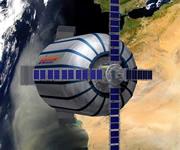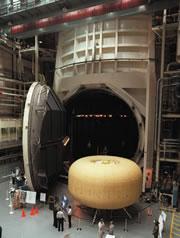 A drawing of what Bigelow's hotel might look like one day.© Bigelow Aerospace.
A drawing of what Bigelow's hotel might look like one day.© Bigelow Aerospace.On 12 July, a rocket took off from a Russian base carrying, among other things, one miniature inflatable space hotel filled with a few cockroaches and several Mexican jumping beans. Borne aloft by a former intercontinental ballistic missile, Genesis I carried Robert Bigelow's dream of a functioning space hotel one step closer to reality.
Just over nine hours later, Bigelow Aerospace reported that its unit had successfully expanded, making those cockroaches and jumping beans the first guests to skitter around a 4-metre-wide watermelon-shaped hostelry, 550 kilometres above Earth.
A US hotelier and millionaire, Robert Bigelow's goal is to create a station at least three times the size of Genesis I, to host both researchers and holidaymakers. But for Bigelow's dream to become a reality, he will first have to convince the world that his inflatable designs can withstand the harsh environment beyond Earth's atmosphere.
Pack it in
“The question is, how long do they hold up?”
Larry Bell
Sasakawa International Center for Space Architecture at the University of Houston, Texas
Inflatable designs are not new in the world of space architecture. Each delivery of goods into space is limited by the size and power of the launch vehicle; an inflatable design allows engineers to compress a large structure into a small, light load.
Genesis I weighed in at about 1,360 kilograms and took up about half its inflated size. Once aloft, it was inflated with compressed air.
Bigelow estimates that his team could create a structure with a core volume of 660 cubic metres using only two of his full-scale inflatable modules. The International Space Station currently has a habitable volume of 425 cubic metres.
Pop goes the hotel
 NASA's TransHab was an inflatable structure that never made it into space thanks to budget cuts.© NASA
NASA's TransHab was an inflatable structure that never made it into space thanks to budget cuts.© NASABut there are obvious disadvantages to inflatable craft. For a giant balloon floating in space, there is always the risk of being punctured.
Constance Adams and her team at NASA dealt with these problems when designing an inflatable called TransHab in the late 1990s. The solution, they found, lay in technologies that had already been developed to make bulletproof vests. By weaving together layers of a synthetic ceramic fabric like Kevlar, Adams and her team created a structure that could withstand the equivalent of a 2-centimetre meteoroid.
The TransHab project was eventually dropped due to budget cuts, but gave Bigelow his inspiration. The walls of his module are made from more than 40 centimetres of layered material, including synthetic ceramics.
Built to last
"The question is, how long do they hold up?" says Larry Bell of the Sasakawa International Center for Space Architecture at the University of Houston, Texas. "Look at your lawn furniture or awnings and so on, and see how they stand up to ultraviolet radiation. Ultraviolet degrades a lot of synthetic structures."
There is also a question of how the material withstands the trauma of being packed for launch, says Bell. "If you fold something very thick very tight, you risk damaging the surface fibres. The inner fibres get crunched, and the outer ones get stretched."
Despite these caveats, the advantages of greater volume packed into less space make such structures a serious option. "Inflatables have permeated the culture in just five or six years," says Adams. "Those guys who do the pretty, airbrushed pictures of travelling to Mars — they're always putting an inflatable in there."
Larger picture
Genesis I should remain in orbit for several years, where it will be monitored to see how it fares. And, with any luck, onboard cameras will send back
ADVERTISEMENT
snaps of the cockroaches and jumping beans to see whether they survived the launch.
Bigelow has already laid plans for the launch of Genesis II this autumn. Although he's not ready to send up people, he will be sending their photographs: you can send your picture into space for US$295.
And in the long term, Bigelow is setting his sights on a US$50 million race to build an orbital vehicle capable of carrying seven astronauts by the end of the decade.
Visit our inflatablespace_hotel.html">newsblog to read and post comments about this story.
Sasakawa International Center for Space Architecture at the University of Houston, Texas
